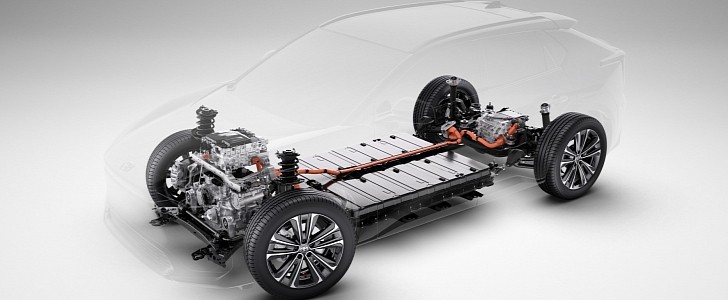One of the most remarkable things Toyota has to offer with the bZ4X is the battery pack warranty. The Japanese carmaker seems pretty confident that it will retain 90% of its capacity after ten years, or 240,000 kilometers (150,000 miles). Without any new tech, we wondered how. Toyota is quietly answering that: it said the AWD version would not fast charge under 32ºF (0ºC).
The information is almost hidden in a document about five main aspects of the bZ4X. In a footnote, Toyota clarifies some of the variables involved with charging and warns that DC charging the EV more than twice a day would negatively affect charging times. Toyota also warns that temperatures below 50ºF (10ºC) would increase it “significantly.”
That is a massive problem for a vehicle that will be sold in cold-weather countries such as Norway, Sweden, and Finland. Even China and the U.S. have some regions where cold temperatures are typical, although Toyota did not seem willing to sell the electric SUV in high numbers in any of these markets.
As we mentioned in the presentation of the bZ4X, it did not come with an 800V system and did not offer any new feature that would make it stand out from the competition. The only thing that seemed extraordinary about it was the warranty. However, it is now clear that it carries a cost that few EV drivers will be willing to pay in places with cold temperatures. Mind you that they do not need to be extreme: anything below 50ºF (10ºC) will already negatively impact the bZ4X.
This is not the first complaint about the charging performance of the bZ4X AWD. Kyle Conner, from the Out of Spec Reviews channel, said that it is the “slowest charging EV” he has ever tested “by a very large margin.” Curiously, Conner mentioned that this bad charging curve is related to the larger battery pack, which comes with CATL cells and delivers 72.8 kWh to the AWD version.
The 71.4-kWh battery pack used by the FWD derivative comes with Panasonic cells and is much faster to charge: it does so at up to 150 kW. The CATL battery pack can only deal with 100 kW. In other words, the Panasonic battery pack is 50% faster to charge.
It is a strong element for customers to prefer the EV with a Panasonic battery pack. At this point, it prompts the question of whether this is a technical limitation with CATL batteries or just something Toyota came up with to restrict the demand for the cell from the Chinese company. We’ll make sure to ask.
That is a massive problem for a vehicle that will be sold in cold-weather countries such as Norway, Sweden, and Finland. Even China and the U.S. have some regions where cold temperatures are typical, although Toyota did not seem willing to sell the electric SUV in high numbers in any of these markets.
As we mentioned in the presentation of the bZ4X, it did not come with an 800V system and did not offer any new feature that would make it stand out from the competition. The only thing that seemed extraordinary about it was the warranty. However, it is now clear that it carries a cost that few EV drivers will be willing to pay in places with cold temperatures. Mind you that they do not need to be extreme: anything below 50ºF (10ºC) will already negatively impact the bZ4X.
This is not the first complaint about the charging performance of the bZ4X AWD. Kyle Conner, from the Out of Spec Reviews channel, said that it is the “slowest charging EV” he has ever tested “by a very large margin.” Curiously, Conner mentioned that this bad charging curve is related to the larger battery pack, which comes with CATL cells and delivers 72.8 kWh to the AWD version.
The 71.4-kWh battery pack used by the FWD derivative comes with Panasonic cells and is much faster to charge: it does so at up to 150 kW. The CATL battery pack can only deal with 100 kW. In other words, the Panasonic battery pack is 50% faster to charge.
It is a strong element for customers to prefer the EV with a Panasonic battery pack. At this point, it prompts the question of whether this is a technical limitation with CATL batteries or just something Toyota came up with to restrict the demand for the cell from the Chinese company. We’ll make sure to ask.






































